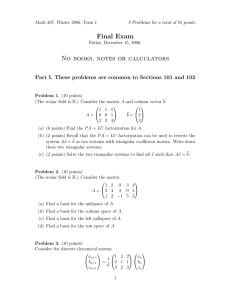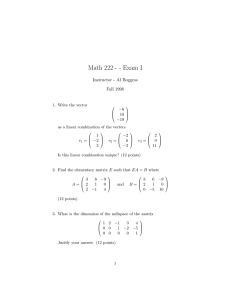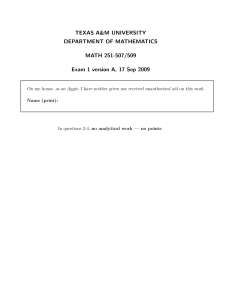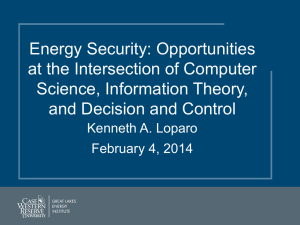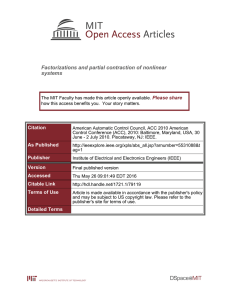Final Exam No books, notes or calculators
advertisement
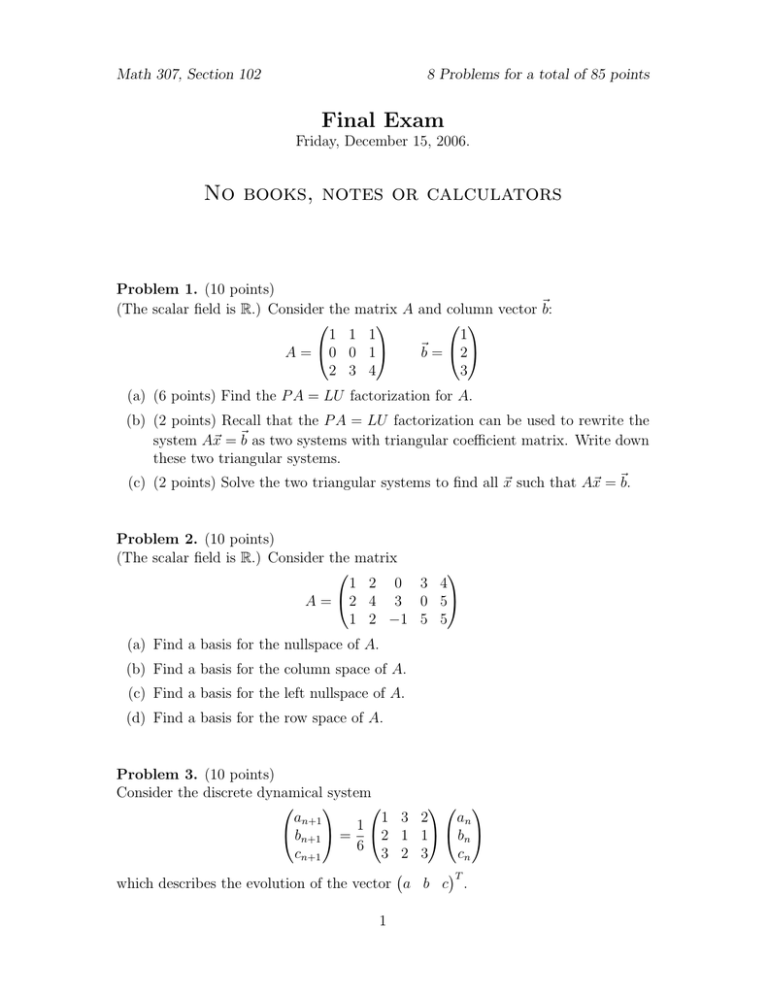
Math 307, Section 102 8 Problems for a total of 85 points Final Exam Friday, December 15, 2006. No books, notes or calculators Problem 1. (10 points) (The scalar field is R.) Consider the matrix A and column vector ~b: 1 1 1 1 ~ A= 0 0 1 b = 2 2 3 4 3 (a) (6 points) Find the P A = LU factorization for A. (b) (2 points) Recall that the P A = LU factorization can be used to rewrite the system A~x = ~b as two systems with triangular coefficient matrix. Write down these two triangular systems. (c) (2 points) Solve the two triangular systems to find all ~x such that A~x = ~b. Problem 2. (10 points) (The scalar field is R.) Consider the matrix 1 2 0 3 4 A = 2 4 3 0 5 1 2 −1 5 5 (a) Find a basis for the nullspace of A. (b) Find a basis for the column space of A. (c) Find a basis for the left nullspace of A. (d) Find a basis for the row space of A. Problem 3. (10 points) Consider the discrete dynamical system 1 3 2 an an+1 bn+1 = 1 2 1 1 bn 6 3 2 3 cn cn+1 T which describes the evolution of the vector a b c . 1 Math 307, Section 102 Final Exam (a) (2 points) Explain what a Markov matrix (stochastic matrix) is and why the coefficient matrix of this discrete dynamical system is a Markov matrix. (b) (6 points) Find a fixed vector for this discrete dynamical system, i.e., a vector T a b c such that an a0 bn = b0 , cn c0 for all n. (c) (2 points) Find the limit of the vector an bn cn initial vector is a0 1 b0 = 1 . c0 39 Problem 4. (15 points) Consider the real matrix A= T as n → ∞ when the 2 1 −8 −2 (a) (7 points) use complex numbers to diagonalize A, this means to find matrices S, Λ, and S −1 , such that A = SΛS −1 , where Λ is diagonal. (b) (2 points) Write down (using complex numbers) the general solution of the system of differential equations d ~x(t) = A ~x(t) . dt (c) (2 points) Discuss the long term behaviour of the solutions of ~x 0 = A ~x. (d) (2 points) Solve the initial value problem x01 (t) = 2x1 (t) + x2 (t) x02 (t) = −8x1 (t) − 2x2 (t) ; x1 (0) = 3 x2 (0) = −2 . (e) (2 points) Write down a (real!) basis for the real vector space of all differentiable functions ~x(t) : R → R2 , satisfying ~x 0 (t) = A x(t), for all t. Problem 5. (8 points) Consider the real matrix 1 0 1 A = 0 1 0 1 0 1 2 Math 307, Section 102 Final Exam (a) (2 points) Explain what property the matrix A has, which assures that you can diagonalize it without the help of complex numbers. (b) (6 points) find a real matrix S and a diagonal matrix D, such that A = SDS T . Problem 6. (12 points) Consider the real matrix 1 0 A= 0 1 1 0 1 0 0 1 0 1 (a) (6 points) Find the QR factorization of A. (b) (3 points) Find the least-squares ‘solution’ to A ~x = ~b, where 1 2 ~b = . 0 −1 (c) (3 points) Find the projection of ~b onto the column space of A. Problem 7. (12 points) Decide whether or not the following statements are true or false. If true, give a proof. If false, give a counterexample. (a) The product of two orthogonal matrices is orthogonal. (b) If AB = I, then BA = I. (Warning: do not assume that A and B are square matrices.) (c) For every 8 × 5 matrix A, dim N (A) ≥ 3 . (d) For every 5 × 5 matrix A with real entries, det(AT A) ≥ 0 . (e) If A ~x = ~b and AT ~y = ~0, then ~y T ~b = 0. 3 Math 307, Section 102 Problem 8. (8 points) Let Final Exam 0 1 A= 1 x 1 0 x 1 (a) Calculate the determinant det A. (b) Find all x such that det A = 0. 4 1 x 0 1 x 1 1 0
